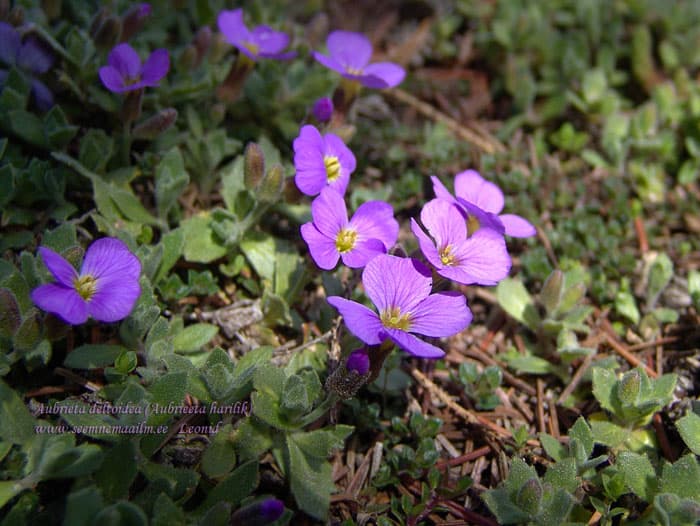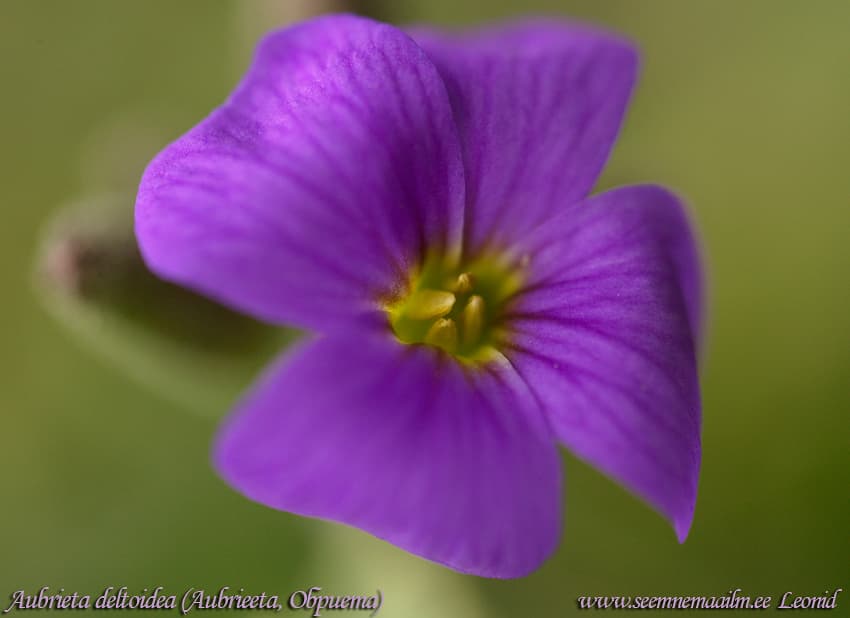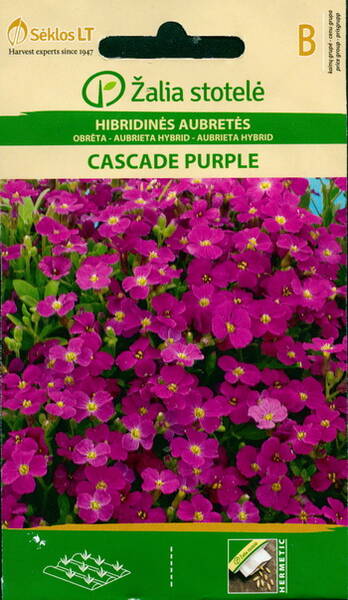Perennial herbaceous plant with creeping branched shoots, up to 10 cm high. Small oval leaves and purple-violet flowers 1 cm in diameter form a beautiful dense carpet.
The plant prefers open sunny areas and light nutrient soils.
The whole plant is very decorative at the time of flowering, when the leaves are almost invisible due to the mass of flowers. Blooms from May for about 35-45 days.
Winters with leaves!
Aubrieta is indispensable for a rocky hill, looks good in flower borders and at the joints of slabs of garden paths.
The optimum soil temperature for seed germination is +18+20 °C.
1,0 g = 2000-2500 seeds.

Agrotechnics.
Sowing: done in late April - May or in November.
Soil: the crop prefers light, not very fertile soils with the addition of lime or chalk. It does not tolerate souring, heavy and waterlogged clays, as well as fatty soil containing peat. Moisture is especially destructive in winter, so plants are planted on rocky hills, on raised or well-drained areas. In Estonia, watering is required only for young plantings or in extremely dry times, but in the southern regions it is simply a must.
Care: Aubrieta is very responsive to surface application of sand (even if the soil is quite light in mechanical composition). It is recommended to mulch it with a layer of 3-5 cm 2-3 times a season. After flowering in May, the plants are immediately cut, which promotes new rapid and more compact growth. Repeated flowering is observed in autumn.
Aubrietas are winter-hardy, but in severe, prolonged winters with sharp temperature fluctuations, some varieties may fall out. Therefore, in the northern regions, light covering with dry leaves is necessary.
Reproduction: cut parts of plants are used for cuttings. They are planted in a greenhouse, in a mixture of equal parts of river sand and peat.
In conditions of artificial fog, the rooting rate of species is quite high - up to 95%. For varieties, it is sometimes no more than 25% (especially if the installation is not adjusted and there is strong over-moistening from above). Rooted cuttings can be planted in a permanent place at the end of August so that they have time to take root, get stronger and be well prepared for winter. The distance when planting is 10-15 cm.
It is advisable to leave the most valuable specimens in the greenhouse until spring. It is recommended to re-cut all varieties every year to avoid their loss, since they become more capricious with age, and in the first year of life they are resistant and winter perfectly.
Aubrieta is easily propagated in open ground by seeds, but the varieties split.
We sow in ridges before winter, since the shoots are quite tender and can easily get lost among the weeds in an unlimited space. Mulching with sand is necessary. Seedlings bloom in the second year.
Aubrieta is also propagated by dividing the bush in spring and even in autumn. This method should be used only in extreme cases (you did not manage to cut the cuttings in time or you urgently need to move the plants to a new place for reasons beyond your control).
Aubrieta, especially varietal, reacts painfully to this operation. It is necessary to divide and plant very carefully. In general, this crop does not like "bad hands", so even experienced people are so careful with it...
Use: Aubrieta is planted on rocky hills and medium-sized rock gardens, on the front edge of the border. In a mixborder, it, so small and elegant, usually gets lost and has difficulty competing with its neighbors. Aubrieta can beautifully cascade down the rocks, it looks especially good along the edge of a wall. Sometimes the crop is used in flowerbeds in the spring, when the primroses have already bloomed, and it is risky to plant seedlings of annuals because of dangerous late spring frosts.
Why hasn't aubrieta become widespread in landscaping?
This is not a plant that can be planted and forgotten. It requires constant attention and love, otherwise one day it will disappear unnoticed and without a trace. Our heroine is undoubtedly suitable only for gardens with individual care and for true amateur gardeners.
Partners: beautiful in combination with yellow alyssums, white iberis, subulate phlox.

Rock Cress. Bot.syn.: Aubrieta×cultorum Bergm.












